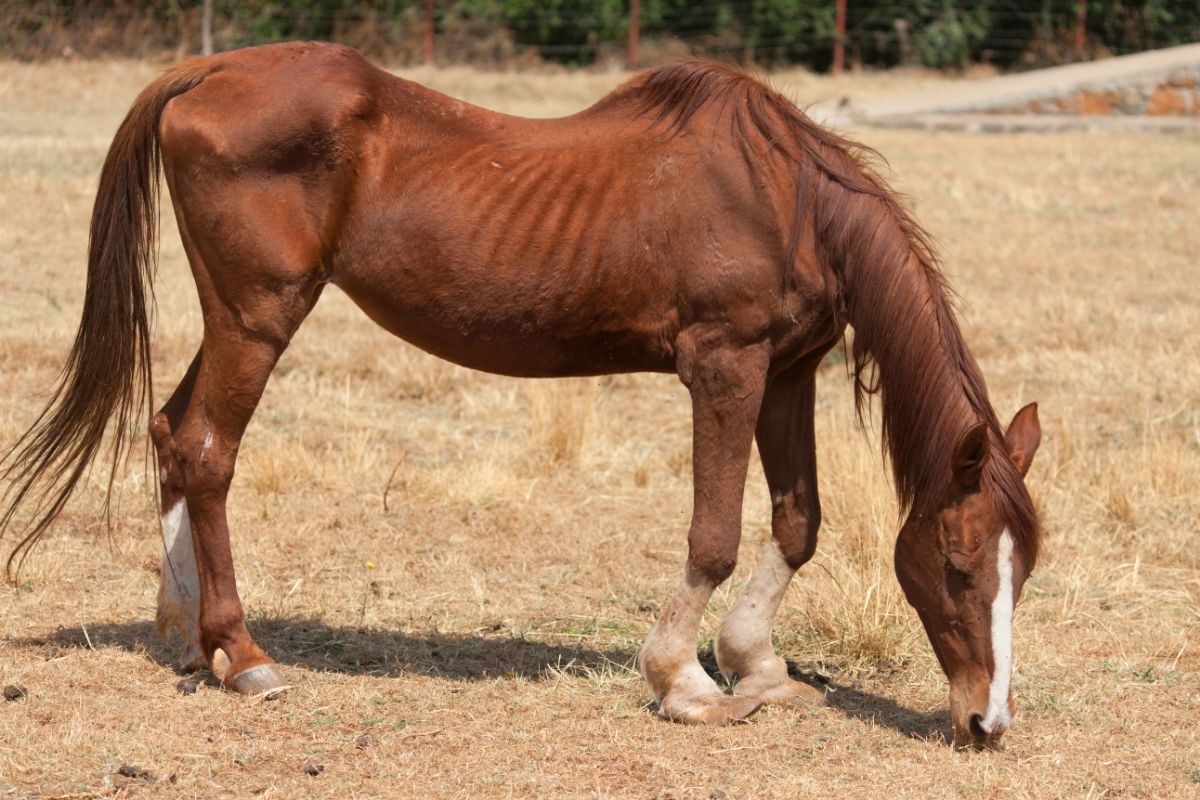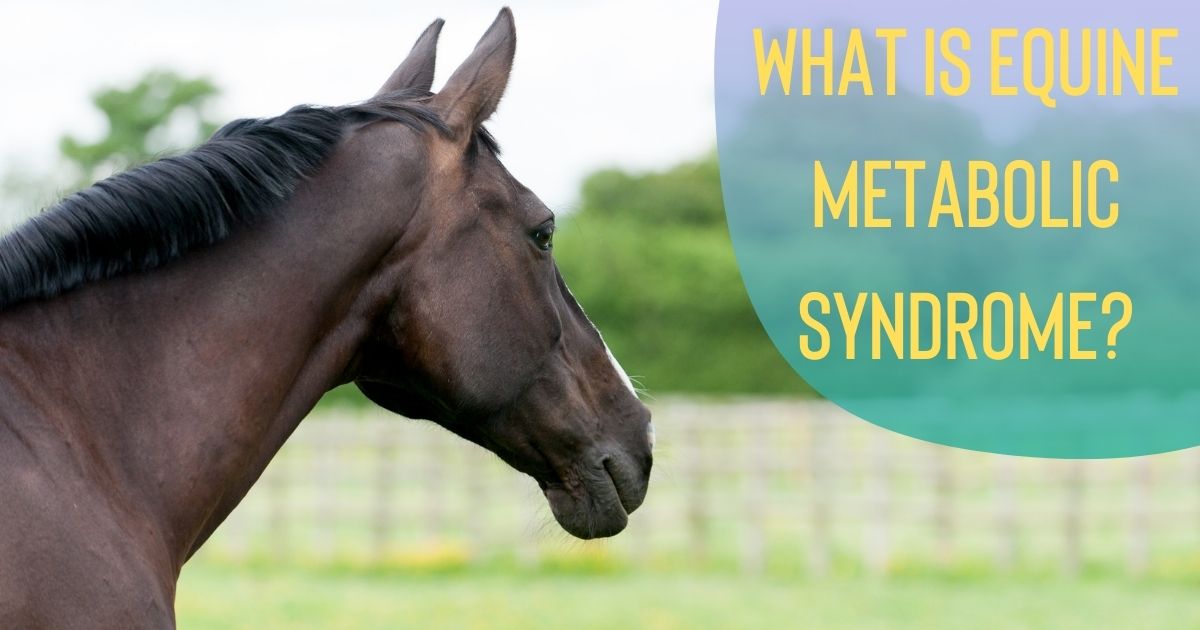Do you own a horse? If so, you know how expensive it can be to keep them healthy and happy. That’s why we want to make sure that you know the signs of equine metabolic syndrome (EMS) in your horses.
It is an illness that affects over half of all horses in America today, but there are ways to manage it if caught early on. We want to help educate people about EMS so they can take proactive steps towards keeping their horses healthy for years to come!
Are you ready for some fun facts about EMS?! Let’s go!!

What Is EMS in Horses?
EMS stands for equine metabolic syndrome. EMS in horses is a disorder where the body produces excess insulin, leading to weight gain and other health issues.
This condition typically occurs when a horse has been fed too much grain or sweet feed without enough exercise over time. It’s closely related to obesity and laminitis, but it can get triggered in horses of any body condition.
Normal Insulin Levels in Horses
Horses with EMS typically have very high levels of insulin circulating in their blood. The average horse has between 2 and 15 micro IU/ml insulin levels. Horses with EMS have insulin levels two to three times the average range for a healthy horse. This is a condition that can be deadly if not treated.
Diabetes in Horses (Symptoms)
Many people are unaware that their horse has diabetes until it suffers from laminitis. Don’t allow laminitis to occur. Stop immediately if you are feeding your horse too much grain or sweet feed. Exercise your horses regularly to promote the breakdown of glucose in their body. This helps reduce insulin levels, which will prevent EMS or laminitis from occurring.
Diabetes mellitus (type 1 or insulin-dependent diabetes) is somewhat more common in horses than people. Weight loss, frequent urination, and increased thirst & hunger are the most common symptoms.
These symptoms may appear in horses with other metabolic diseases, and blood tests can assist in the distinction of diabetic animals from those with a specific condition.
Other diabetes in horses symptoms include:
- Excitement and anxiety (a sign that they need insulin injections)
- Loss of muscle mass
- Bone fractures and weakness
- Slow-healing wounds and hoof cracks
Insulin Resistance in Horses (Treatment)
Insulin resistance in horses is a condition that you can manage through dietary, exercise, and management changes. The most common treatment for equine insulin resistance in horses is to reduce grain and sweet feed and increase hay and pasture.
Once your horse is diagnosed with EMS, there are three feeding options you can choose from to treat it. These are high starch diets, low starch diets, and the feeding of highly fermentable carbohydrates. Each one has its benefits to your horse.
For example, horses on a high starch diet will often experience reduced insulin secretion than those on a low starch diet. However, there is still an increased risk of these horses developing laminitis. Conversely, horses on a low-starch diet will not risk developing laminitis because they produce less insulin in their pancreas.
You should keep horses affected by EMS at a lean body condition, which can be achieved by increasing exercise and keeping them on a strict diet. Exercise is also an essential aspect in reducing insulin production and ensuring that the body is getting used to breaking down glucose without the help of excess insulin.
This dietary change must also include the appropriate supplementation with vitamins and minerals to ensure that the horse is getting all of its other necessary nutrients. Exercise is also an essential aspect in reducing insulin production and ensuring that the body is getting used to breaking down glucose without the help of excess insulin.
This disease is challenging to manage but has been made easier due to the advancement of equine veterinary medicine.
When Does Equine Metabolic Syndrome Develop in Horses?
Equine metabolic syndrome is common in obese horses fed sweet feed or grain without enough exercise. It can also develop when a horse has rapidly gained weight over a short time.
This condition typically develops in older horses, but it can also occur in younger horses. Contact your veterinarian immediately if you suspect that your horse may have this condition.
Diagnosing EMS in Horses
You can look for many signs if you suspect your horse has EMS. These include excessive drinking and urination, weight gain despite diet and exercise, increase in appetite but poor body condition, and finally, decreased body condition despite increased appetite and diet.
Once you have identified these symptoms in your horse, the next step is to get it tested by a veterinarian. The veterinarian will perform various lab tests on your horse and take its history and blood type into account when deciding to test for EMS.
The insulin and glucose levels in the blood are commonly what vets screen for EMS, and this is useful for detecting animals with mild to severe insulin imbalance. However, in non-affected animals, metabolic problems may not yet be tough enough to detect, and dynamic tests are required to identify insulin resistance.
Intravenous and oral glucose tolerance tests assess bodily responses, particularly for abnormally high insulin responses. For example, underweight horses will often have a higher insulin concentration in their blood.
This allows the veterinarian to test for EMS by checking for an increased insulin concentration while checking for other conditions, such as Cushing’s disease.
Before enough laminar tissue damage occurs to cause lameness, early detection of EMS allows for management adjustments to encourage weight reduction and improve insulin sensitivity before substantial amounts of laminar tissue damage happen.

Can Equine Metabolic Syndrome be Prevented
The goal of equine metabolic syndrome prevention should be to keep horses, especially high-risk breeds, at a healthy weight. Because these horses may be more efficient calorie users, feeding appropriately to maintain an optimal BCS rather than following arbitrary feeding rules is critical.
Take extra precautions when putting horses out on pasture during high soluble carbohydrate content periods (spring and autumn).
Other prevention strategies include:
- Establish a healthy weight and body condition score at the start of life.
- Implementing good dental care, as mouth discomfort has a link to insulin resistance in some horses.
- Breeders can wait until clinical signs are present before breeding an individual who may carry an at-risk gene.
- Monitoring insulin levels in horses that are obese or overweight, as these horses may be at a higher risk of developing the syndrome.
- Using appropriate hay, such as alfalfa and grass hays rather than legume hays like clover and soybean, have higher sugar content.
- Performing hay testing to quantify the essential carbohydrates and calorie content of a bale of hay can help you make better decisions about what and how much to feed.
- By feeding responsibly and making some common-sense management changes, you might be able to prevent metabolic syndrome from becoming a severe threat to the equine population.
How Does EMS Affect Horses?
Equine metabolic syndrome, also known as pigeon breast disease, affects only horses. The fat deposited around the horse’s abdomen resembles that of pigeons, hence the name given to this disease.
EMS makes it difficult for horses to regulate their insulin levels through healthy eating habits and exercise alone. Insulin is a hormone released by the pancreas to help regulate blood sugar levels.
Insulin enables cells in the body to absorb glucose (sugar) for energy and is controlled by what food you give your horse, the type of exercise it gets, how much insulin it produces naturally, and its ability to use insulin easily. A horse’s pancreas must make the correct amount of insulin based on the previous four factors for your horse to maintain healthy blood sugar levels.
EMS affects horses by causing high blood sugar, poor body condition, and early death. Horses affected by EMS gain weight easily because they cannot use insulin properly. This weight gain leads to further complications, such as laminitis and coronary band damage.
Laminitis is a disease that causes a horse to lose the ability to walk, and coronary band damage leads to decreased production of hoof growth.
What Are the Causes of Equine Metabolic Syndrome?
The exact causes of this disease are unknown at this moment, but scientists believe some risk factors can trigger its development. So let’s take a look at the most probable causes of equine metabolic syndrome.
The most critical risk factor for the development of this condition is obesity. In metabolic syndrome, horses malfunction from normal insulin signaling and insulin resistance.
Scientists believe that the accumulation of fat cells around the abdomen produces “lipotoxicity,” which can disrupt cell function due to excess lipid accumulation. Lipid inflammation is one of the possible mechanisms that can cause insulin resistance and decrease glucose uptake by muscles.
Insulin resistance in horses means high circulating glucose levels, which reduces glucose within the cells, often leading to increased triglyceride levels and fatty deposits around organs such as the heart and liver.
Several factors can predispose horses to become obese and develop insulin resistance. One is the reduction in physical activity, mainly when associated with a decrease in exercise load. This is the case with horses confined to small spaces or kept in stables. Poor-quality pastures can also contribute because they reduce the fiber that horses can eat.
Genetics can also play a significant role in developing metabolic syndrome. Therefore, horses with parents who are obese or have had issues with metabolic syndrome are predisposed to this condition.
Finally, hormonal imbalances such as hypothyroidism and equine Cushing’s disease can contribute to obesity, insulin resistance, and lipid accumulation.
Scientists emphasize the need to monitor weight gain, body condition, and lipid profile in horses predisposed to obesity. Additionally, feeding management is critical for the prevention of metabolic syndrome. This is especially the case when owners know that their horses are predisposed to this condition.
When Should I Test my Horse for EMS?
You should test your horse for this condition if you, or a veterinarian, discovers that it is overweight. Additionally, it is a good idea to test a horse whose parent has had issues with obesity, insulin resistance, or lipid accumulation.

That’s a Wrap
Equine metabolic syndrome is a condition that affects horses and can cause them to become obese. It results from a combination of genetics and environment and can lead to health problems such as laminitis, insulin resistance, and Cushing’s disease. In addition, if left untreated, it can lead to other health problems for the horse.
Treatment options are available, and early diagnosis is vital for the best possible outcome for the horse. Treatment for equine metabolic syndrome usually involves diet and exercise modifications and medication in some cases.
